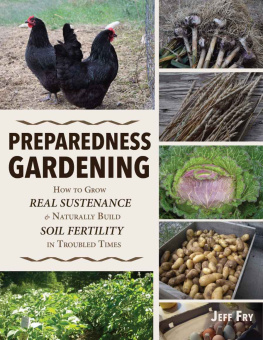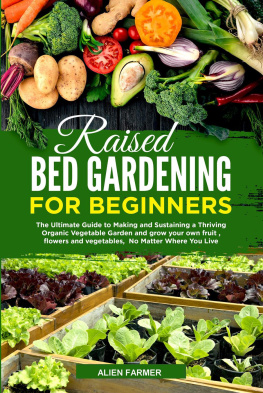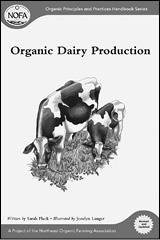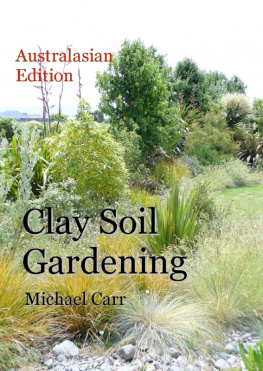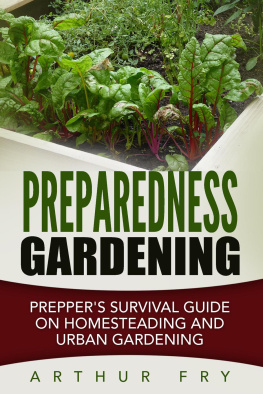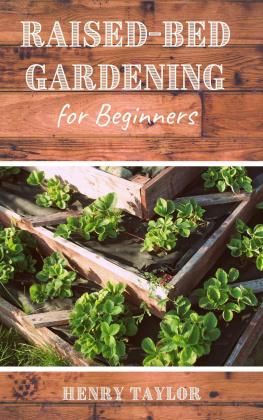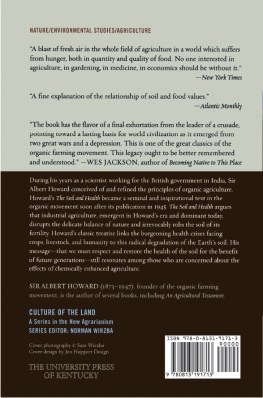Jeff Fry - Preparedness Gardening: How to Grow Real Sustenance and Naturally Build Soil Fertility in Troubled Times
Here you can read online Jeff Fry - Preparedness Gardening: How to Grow Real Sustenance and Naturally Build Soil Fertility in Troubled Times full text of the book (entire story) in english for free. Download pdf and epub, get meaning, cover and reviews about this ebook. year: 2016, genre: Children. Description of the work, (preface) as well as reviews are available. Best literature library LitArk.com created for fans of good reading and offers a wide selection of genres:
Romance novel
Science fiction
Adventure
Detective
Science
History
Home and family
Prose
Art
Politics
Computer
Non-fiction
Religion
Business
Children
Humor
Choose a favorite category and find really read worthwhile books. Enjoy immersion in the world of imagination, feel the emotions of the characters or learn something new for yourself, make an fascinating discovery.
Preparedness Gardening: How to Grow Real Sustenance and Naturally Build Soil Fertility in Troubled Times: summary, description and annotation
We offer to read an annotation, description, summary or preface (depends on what the author of the book "Preparedness Gardening: How to Grow Real Sustenance and Naturally Build Soil Fertility in Troubled Times" wrote himself). If you haven't found the necessary information about the book — write in the comments, we will try to find it.
Jeff Fry: author's other books
Who wrote Preparedness Gardening: How to Grow Real Sustenance and Naturally Build Soil Fertility in Troubled Times? Find out the surname, the name of the author of the book and a list of all author's works by series.
Preparedness Gardening: How to Grow Real Sustenance and Naturally Build Soil Fertility in Troubled Times — read online for free the complete book (whole text) full work
Below is the text of the book, divided by pages. System saving the place of the last page read, allows you to conveniently read the book "Preparedness Gardening: How to Grow Real Sustenance and Naturally Build Soil Fertility in Troubled Times" online for free, without having to search again every time where you left off. Put a bookmark, and you can go to the page where you finished reading at any time.
Font size:
Interval:
Bookmark:
Table of Contents
INTRODUCTION
1 BREAKING GROUND
2 SHAPING GROUND
SWALES
RAISED OR SUNKEN BEDS
THE SHAPE OF YOUR GARDEN
PUTTING IT ALL TOGETHER
3 BUILDING GROUND & THE SOIL FOODWEB
FERTILIZING & AMENDING SOIL
WORKING WITH TREES
OTHER ORGANIC FERTILIZERS
TRACE MINERAL PRODUCTS & OTHER AMENDMENTS
ROCK DUST
SEA MINERALS
BIOCHAR
PRACTICES THAT PROTECT AND BUILD YOUR SOIL FOR THE LONG-TERM
THE NRCS PRINCIPLES OF BUILDING SOIL HEALTH
A RESILIENT SOIL DRY GARDENING IF TIMES GET REALLY BAD
SOIL
EARTHWORKS FREDGES, SWALES, TERRACES, RAISED/SUNKEN BEDS
PLANT VARIETY & THE GREAT DRY GARDENING POTATO EXPERIMENT
SHADE & MULCH
OTHER DRY GARDENING ODDITIES (& FAILS)
4 YOUR STAPLES
A NOTE ON THE TRADITIONAL DIET
YOUR STAPLES
POTATOES
CORN (or not)
OTHER GRAINS WHEATS, RYE, BARLEY, OATS
(WINTER) SQUASH
LEGUMES (BEANS & PEAS)
EGGS
ROOTS
BRASSICA FAMILY / FERMENTABLES
PUTTING IT ALL TOGETHER GARDEN PLANS
5 A WORD ON TOOLS & SEED SAVING + GREAT INFORMATION SOURCES
TOOLS
SEED SAVING
BIBLIOGRAPHY
Without question, we live in dangerous and unprecedentedtimes. We are inching towards thebiggest economic collapse in history which is threatening enough on itsown on top of risks of civil unrest, international war, severe weatherand natural disasters, terrorist or cyber attacks, and more. Against these, our centralized,just-in-time food delivery system, dependent upon a fragile web of power gridsand telecommunication networks, is extremely vulnerable. If civilization is indeed threemeals away from anarchy, there is no question that food preparedness in ourtroubled times is vital.
When it comes to producing our own food, there are few booksthat address self-reliant gardening. Almost invariably, contemporary gardening books are written for marketgardening or pleasure gardening, neither of which is interested in developingfood resiliency in the face of crises.
Preparedness Gardening meets that need by outlining how togarden for the purpose of food preparedness so that we can have that crucialstock of fresh food to see us through a food shortage and/or to significantlyoffset our grocery costs in economically hard times.
My own entry into self-reliant gardening came years ago when Islowly came to realize just how helpless I would be in a food crisis despitebeing well-educated and able-bodied. Since then, I have been an avid researcher and reader on everythingrelated to growing (and raising) food and have applied various methods to thefields of our modest homestead.
In the interior of British Columbia, Canada, we have summers ofintense heat and dryness like you might find in California (usually about twomonths of weather between 37- 42C (98- 107F )) but with a winter far colder and a season much, muchshorter. It is a tough growingclimate for many items but it also provides rigorous conditions to testdifferent agricultural solutions. For example, if I can make dry-gardening work here with such heat anddryness, the odds are you can make it work too. Dry gardening is an important topic inthe context of preparedness that is covered in these pages.
Preparedness Gardening addresses how to create a garden, big orsmall, for the first time; how to supercharge soil health by using the power ofbio-mimicry and microbiology; and what staple and nutrient crops to consider all interwoven with a preparedness point of view and a minimalistapproach.
These methods applied, you can have vital, rich food to providefor yourself through tough times and do it in a way that is organic andelegantly efficient. I believe thisto be a part of a new local food renaissance thatsees individuals, families, and communities take back far greater control oftheir food supply in the pursuit of security, independence, and health.
As preparedness aphorisms go, a year too early isbetter than a day too late, and this is especially true with gardening. You need all the time and experience youcan get to grow well in your nook of the world. So, whether you are new to gardening orare looking to change your approach in the face of hard times, the informationhere will provide the framework you need get started as well as point you tosome of the best resources out there to support your food preparedness.
Happy Gardening!
BREAKING GROUND
Breaking ground for the first time can be a thrilling processand impart a real feeling of accomplishing something meaningful with yourhands. For small plots (say, lessthan 500 square feet), you have several methods available to you:
1) Themost luxurious, bound-to-create-a-thriving-garden method is to create amultilayered sheet mulch, also regrettably referred to as lasagnagardening. There are differentways of doing this, but the idea is to smother what is growing, usually grass,with a thick compost-in-place and then grow directly out of it the followingspring after the material has at least partially broken down and natureshelpers have gently begun digesting and tilling in the materials. This can be as simple as cardboard witha layer of mulch or compost on top (a little dicey) or a complex, multilayeredcompost bed. Permaculture authorToby Hemenway outlines his ultimate sheet mulch ashaving first a thin layer of slashed vegetation, followed by soil amendmentslike rock powers, a thin layer of manure, newspaper or cardboard a half inchthick, more manure or nitrogenous material a half inch thick, 8-12 inches ofstable bedding or other bulk organic matter, another inch or two of compost,and finally a couple inches of straw or leaves (87-90 Gaias Garden). Itmight go without saying that this is only suitable for very small spaces as thevolume of material here is enormous.
2) Rotarytilling: Probably the most common on the home- and market scale, rotary tillingshould prepare your garden bed as well as irritate the bejeezus out of you. It is crucial to note,though, that how many passes you must do to sufficiency till your grounddepends on your ground and your tiller. A high quality walking tractor can handle just about anything but lessermodels may not. My lowly tillercould not really manage even a thick sod, or rocky ground, or dusty or hotconditions in short, nothing other than already prepared garden soil inagreeable weather.
3) Byshovel: Slower, yes, but the quality of the tilling is much better. Most grasses can be killed completely byflipping the sod upside down. Thisis also a resilient method of breaking ground in the sense that it requiresnothing more than you (and hopefully some helpers) and a shovel(s). In about a week of irregular bouts ofwork, I broke roughly 3000 square feet of ground using this method two seasonsago with a helper for half of that time. The method is simply to bite off chunks of sod and flip them on theirside or head, then move a step to the side and repeat. Leave them die upside down for a week ortwo, do more tilling and chopping if necessary, and rake the bed level.
It should be noted here that some intensive garden bed styles encourage adouble-digging where you shovel two shovels down roughly two feet to deeply aerate and fluff the soil. Having spent a season using this method,I can confirm that it is feasible in a small space only because it isoutlandishly labour intensive and anyway not necessary as healthy soilbiota together with smart cover cropping will aerate your soil, the latter ofwhich is the goal of good soil management. 
4) Bychicken power: If you have chickens, you will already be perfectly familiarwith their ability to turn an area into a patch of moon where nary a blade ofgrass or bug shall exist. They willturn sod into manure and eggs, have a good time doing it, and entertain you toboot. Some additional wood chips orother organic material tossed into the patch will lesson compaction, which thechickens will also do. After theyhave done their work, a cover crop can be planted to further build the soil forthe next season; or you could feasibly plant a late season crop after somehoeing or tilling to loosen up the ground. How long it takes depends on the space, the ground, how many chickensyou have, and what kind of chickens.
Font size:
Interval:
Bookmark:
Similar books «Preparedness Gardening: How to Grow Real Sustenance and Naturally Build Soil Fertility in Troubled Times»
Look at similar books to Preparedness Gardening: How to Grow Real Sustenance and Naturally Build Soil Fertility in Troubled Times. We have selected literature similar in name and meaning in the hope of providing readers with more options to find new, interesting, not yet read works.
Discussion, reviews of the book Preparedness Gardening: How to Grow Real Sustenance and Naturally Build Soil Fertility in Troubled Times and just readers' own opinions. Leave your comments, write what you think about the work, its meaning or the main characters. Specify what exactly you liked and what you didn't like, and why you think so.

